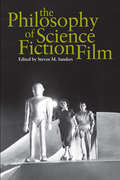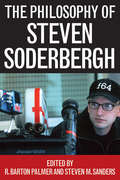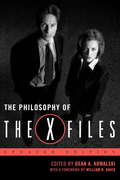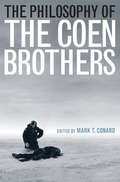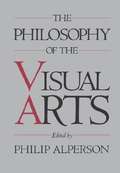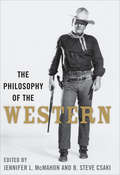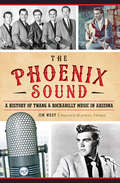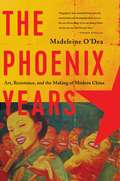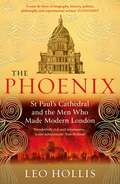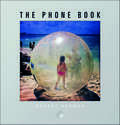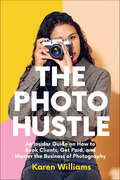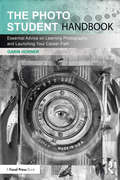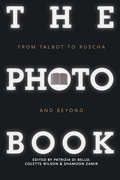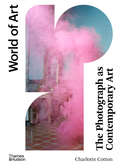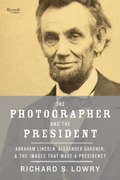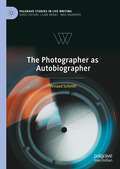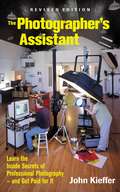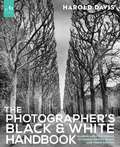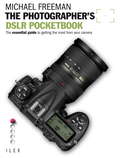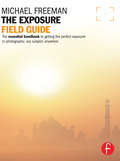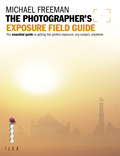- Table View
- List View
The Philosophy of Science Fiction Film (The\philosophy Of Popular Culture Ser.)
by Steven M. SandersThought-provoking essays on movies from Metropolis to The Matrix. The science fiction genre, through films such as Blade Runner, Invasion of the Body Snatchers, and The Terminator, not only entertains us but makes us think—about the implications of new technologies, the parameters and possibilities of space and time, and, in the age of artificial intelligence and robotics, the meaning of humanity itself. The Philosophy of Science Fiction Film explores the storylines, conflicts, and themes of fifteen science fiction film classics. Editor Steven M. Sanders and a group of outstanding scholars in philosophy, film studies, and other fields raise science fiction film criticism to a new level by penetrating the surfaces of the films to expose the underlying philosophical arguments, ethical perspectives, and metaphysical views.
The Philosophy of Steven Soderbergh (The Philosophy of Popular Culture #Ppcs)
by R. Barton Palmer and Steven M. Sanders&“Provocative, insightful, and instructive analysis of the cinematic and philosophical significance of Steven Soderbergh&’s work.&” —Jason Holt, editor of The Daily Show and Philosophy: Moments of Zen in the Art of Fake News Widely regarded as a turning point in American independent cinema, Steven Soderbergh's sex, lies, and videotape launched the career of its twenty-six-year-old director, whose debut film was nominated for an Academy Award and went on to win the Cannes Film Festival&’s top award, the Palme d&’Or. The Philosophy of Steven Soderbergh breaks new ground by investigating salient philosophical themes through the unique story lines and innovative approaches to filmmaking that distinguish this celebrated artist. Editors R. Barton Palmer and Steven M. Sanders have brought together leading scholars in philosophy and film studies for the first systematic analysis of Soderbergh&’s entire body of work, offering the first in-depth exploration of the philosophical ideas that form the basis of the work of one of the most commercially successful and consistently inventive filmmakers of our time.
The Philosophy of The X-Files: Updated Edition (The Philosophy of Popular Culture #Ppcs)
by Dean A. KowalskiLearn to search for the truth that&’s out there in essays about what &“may be the most philosophically challenging series in the history of television&” (Paul A. Cantor, author of Gilligan Unbound: Pop Culture in the Age of Globalization). In The Philosophy of The X-Files, Dean A. Kowalski has gathered a remarkable cast of contributors to shed light on the philosophical mysteries of the television show The X-Files. With sections devoted to the show&’s credos—&“The truth is out there,&” &“Trust no one,&” and &“I want to believe&” —as well as individual characters and specific episodes, The Philosophy of The X-Files illuminates the philosophical assumptions and presuppositions of the show and provides a lively, accessible way to better understand philosophy and philosophical inquiry—while exploring topics ranging from alienation to determinism to democracy.
The Philosophy of the Coen Brothers (The Philosophy of Popular Culture #Ppcs)
by Mark T. Conard&“Written for both fans of the Coen brothers and the philosophically curious, without the technical language . . . educational and entertaining.&” —Library Journal Joel and Ethan Coen have made films that redefined the gangster movie, the screwball comedy, the fable, and the film noir, but no matter what genre they&’re playing with, they consistently focus on the struggles of complex characters to understand themselves and their places in the strange worlds they inhabit. To borrow a phrase from Barton Fink, all Coen films explore &“the life of the mind&” and show that the human condition can often be simultaneously comic and tragic, profound and absurd. The essays in this book explore the challenging moral and philosophical terrain of the Coen repertoire. Several address how Coen films often share film noir&’s essential philosophical assumptions: power corrupts, evil is real, and human control of fate is an illusion. In Fargo, not even Minnesota&’s blankets of snow can hide Jerry Lundegaard&’s crimes or brighten his long, dark night of the soul. The tale of love, marriage, betrayal, and divorce in Intolerable Cruelty transcends the plight of the characters to illuminate competing theories of justice. Even in lighter fare, such as Raising Arizona and The Big Lebowski, the comedy emerges from characters&’ journeys to the brink of an amoral abyss. However, the Coens often knowingly and gleefully subvert conventions and occasionally offer symbolic rebirths and other hopeful outcomes. At the end of The Big Lebowski, for example, the Dude abides, his laziness has become a virtue, and the human comedy is perpetuating itself with the promised arrival of a newborn Lebowski. The Philosophy of the Coen Brothers sheds new light on the work of these cinematic visionaries. From Blood Simple to No Country for Old Men, the Coens&’ characters look for answers—though in some cases, their quest for answers leads, at best, only to more questions.
The Philosophy of the Visual Arts
by Philip A. AlpersonMost instructors who teach introductory courses in aesthetics or the philosophy of arts use the visual arts as their implicit reference for "art" in general, yet until now there has been no aesthetics anthology specifically orientated to the visual arts. This text stresses conceptual and theoretical issues, first examining the very notion of "the visual arts" and then investigating philosophical questions raised by various forms, from painting, the paradigmatic form, to sculpture, photography, film, dance, kitsch, and other forms on the borders of the visual arts. The selections represent both classical and contemporary views and include sections by artists, art historians, and critics as well as philosophers. A singularly important text for courses in the philosophy of arts or aesthetics, this anthology is designed to enrich the philosophical and critical examination of our beliefs about the visual arts.
The Philosophy of the Western (The Philosophy of Popular Culture #Ppcs)
by Jennifer L. McMahon and B. Steve CsakiEssays about how stories of the Old West reflect—and affect—our beliefs and values.The solitude of the lone rider, the loyalty of his horse, and the unspoken code of the West—for many, Western movies embody America and its values, though the view of the country&’s history they present isn&’t always accurate. In recent years, scholars had declared the genre dead, but a steady resurgence of western themes in literature, film, and television has reestablished its importance and influence.In The Philosophy of the Western, editors Jennifer L. McMahon and B. Steve Csaki examine philosophical themes in the western genre. Investigating subjects of nature, ethics, identity, gender, environmentalism, and animal rights, the essays in this volume draw from a wide range of westerns including the more recent popular and critical successes Unforgiven, All the Pretty Horses, 3:10 to Yuma, and No Country for Old Men, as well as literature and television serials such as Deadwood. The Philosophy of the Western reveals the powerful role of the western in the American psyche.
The Phoenix Sound: A History Of Twang And Rockabilly Music In Arizona
by Jim WestIn 1956, a fresh-faced Sanford Clark recorded "The Fool" with guitarist Al Casey at Floyd Ramsey's small Phoenix recording studio. Written by local deejay Lee Hazlewood, the song became a top-ten Billboard hit nationwide and launched a new trailblazing era of Arizona music. Their success paved the way for other Phoenix acts and producers to chart national hits. Grammy-winning audio engineer Jack Miller started out in Ramsey's studio, and Hazlewood produced rock hall of famer Duane Eddy's debut album, Have "Twangy" Guitar, Will Travel. These early artists pioneered a sound that inspired Arizona's best musicians from Waylon Jennings and Buck Owens to Stevie Nicks and Linda Ronstadt. Join former radio and broadcast personality Jim West for the story and soundtrack to the early days of music in the Valley of the Sun.
The Phoenix Years: Art, Resistance, And The Making Of Modern China
by Madeleine O'DeaAt once a fascinating account of the birth of modern China and a moving chronicle of courage, creativity, and resistance. The riveting story of China's rise from economic ruin to global giant in the past four decades is illuminated by another, equally fascinating, narrative beneath its surface—the story of the country's emerging artistic avant-garde and the Chinese people's ongoing struggle for freedom of expression. By following the stories of nine contemporary Chinese artists, The Phoenix Years shows how China's rise unleashed creativity, thwarted hopes, and sparked tensions between the individual and the state that continue to this day. It relates the heady years of hope and creativity in the 1980s, which ended in the disaster of the Tiananmen Square massacre. Following that tragedy comes China's meteoric economic rise, and the opportunities that emerged alongside the difficult compromises artists and others have to make to be citizens in modern China. Foreign correspondent Madeleine O'Dea has been an eyewitness for over thirty years to the rise of China, the explosion of its contemporary art and cultural scene, and the long, ongoing struggle for free expression. The stories of these artists and their art mirror the history of their country. The Phoenix Years is vital reading for anyone interested in China today.
The Phoenix: St. Paul's Cathedral And The Men Who Made Modern London
by Leo Hollis'A tour de force of biography, history, politics, philosophy and experimental science' ECONOMISTThe remarkable and inspiring story of how London was transformed after the Great Fire of 1666 into the most powerful city in the world, and the men who were responsible for that achievement. 'Wonderfully rich and informative ... a rare achievement' Tom Holland'Fascinating' Lucy Moore'An ingenious and fluent overview of extraordinary men at an extraordinary moment, with St Paul's standing as its symbolic heart' SUNDAY TELEGRAPHOpening in the 1640s, as the city was gripped in tumult leading up to the English Civil War, THE PHOENIX charts the lives and works of five extraordinary men, who would grow up in the chaos of a world turned upside down: the architect, Sir Christopher Wren; gardener and virtuosi, John Evelyn; the scientist, Robert Hooke; the radical philosopher, John Locke and the builder, Nicholas Barbon.At the heart of the story is the rebuilding of London's iconic cathedral, St Paul's. Interweaving science, architecture, history and philosophy, THE PHOENIX tells the story of the formation of the first modern city.
The Phoenix: St. Paul's Cathedral And The Men Who Made Modern London
by Leo Hollis'A tour de force of biography, history, politics, philosophy and experimental science' ECONOMISTThe remarkable and inspiring story of how London was transformed after the Great Fire of 1666 into the most powerful city in the world, and the men who were responsible for that achievement. 'Wonderfully rich and informative ... a rare achievement' Tom Holland'Fascinating' Lucy Moore'An ingenious and fluent overview of extraordinary men at an extraordinary moment, with St Paul's standing as its symbolic heart' SUNDAY TELEGRAPHOpening in the 1640s, as the city was gripped in tumult leading up to the English Civil War, THE PHOENIX charts the lives and works of five extraordinary men, who would grow up in the chaos of a world turned upside down: the architect, Sir Christopher Wren; gardener and virtuosi, John Evelyn; the scientist, Robert Hooke; the radical philosopher, John Locke and the builder, Nicholas Barbon.At the heart of the story is the rebuilding of London's iconic cathedral, St Paul's. Interweaving science, architecture, history and philosophy, THE PHOENIX tells the story of the formation of the first modern city.
The Phone Book
by Robert HermanAll the photos were made with the iPhone and the Hipstamatic AppPhotos taken in many locations throughout the worldReveals that the iphone can be taken seriously as a camera
The Photo Hustle: An Insider Guide on How to Book Clients, Get Paid, and Master the Business of Photography
by Karen WilliamsUnlock the Secrets to Commercial Photography SuccessThe Photo Hustle by Karen Williams is the ultimate guide for photographers looking to break into the world of commercial photography, providing insider knowledge on how to land and keep prestigious clients.#1 Best Seller in Photography Business & CareersLooking for photo jobs or careers in photography? Karen Williams, a seasoned photo editor for top brands like Netflix and Wired, reveals the insider knowledge you need to land your dream gigs. The Photo Hustle is the ultimate resource for photographers—beginners and professionals alike—ready to transform their passion into a thriving career in commercial photography. Photography isn&’t just about capturing stunning images; it&’s about understanding the business, overcoming workplace discrimination, and navigating the unwritten rules of the industry. Whether you&’re eyeing jobs involving photography, launching your first photo studio, or breaking into commercial photography, this book equips you with the tools to succeed and the confidence to thrive. Inside, you&’ll find: Practical steps for building your personal brand and landing photo jobs. Expert tips on pitching, creating estimates, and negotiating contracts for photography careers near you and beyond. Strategies to navigate workplace discrimination and adapt to industry trends in photography occupations. Perfect for those seeking photography books for beginners or seasoned pros looking to level up, The Photo Hustle is your go-to guide to break into the competitive world of commercial photography and claim the success you deserve.If you liked What They Didn&’t Teach You in Photo School, Learning to See, or Wisdom of Wildly Creative Women, you&’ll love The Photo Hustle.
The Photo Student Handbook: Essential Advice on Learning Photography and Launching Your Career Path
by Garin HornerThe Photo Student Handbook is a collection of short, easy-to-read chapters filled with expert advice on enhancing image-making skills and launching a career as a professional photographer. Designed to help students grow beyond the technical aspects of photography, this book presents a variety of methods and strategies proven to strengthen visual awareness, engage creative thinking, and deepen the conceptual aspects of image-making. Topics include how to: - improve the ability to see actively - understand light as a main character - cultivate a creative mind - make a standout portfolio - unpack critical theory - find and develop a creative voice. Packed with valuable tips, insights, and advice from over a hundred instructors, professionals, senior students, and experts, this book is engineered to help instructors guide students step-by-step through the methods and strategies needed to achieve creative success both in the classroom and the real world. This book is ideal for intermediate- and advanced-level photography students and instructors alike. Visit the accompanying website www.photostudent.net for extra chapters, exercises, quizzes, and more.
The Photobook: From Talbot to Ruscha and Beyond
by Patrizia Di Bello; Colette Wilson; Shamoon ZamirThe photograph found a home in the book before it won for itself a place on the gallery wall. Only a few years after the birth of photography, the publication of Henry Fox Talbot's "The Pencil of Nature" heralded a new genre in the history of the book, one in which the photograph was the primary vehicle of expression and communication, or stood in equal if sometimes conflicted partnership with the written word. In this book, practicing photographers and writers across several fields of scholarship share a range of fresh approaches to reading the photobook, developing new ways of understanding how meaning is shaped by an image's interaction with its text and context and engaging with the visual, tactile and interactive experience of the photobook in all its dimensions. Through close studies of individual works, the photobook from fetishised objet d'art to cheaply-printed booklet is explored and its unique creative and cultural contributions celebrated.
The Photograph as Contemporary Art: Third Edition (World of Art #0)
by Charlotte CottonA new edition of the definitive title in the field of contemporary art photography by one of the world’s leading experts on the subject, Charlotte Cotton. In the twenty-first century, photography has come of age as a contemporary art form. Almost two centuries after photographic technology was first invented, the art world has fully embraced it as a legitimate medium, equal in status to painting and sculpture. The Photograph as Contemporary Art introduces the extraordinary range of contemporary art photography, from portraits of intimate life to highly staged directorial spectacles. Arranged thematically, the book reproduces work from a vast span of photographers, including Andreas Gursky, Barbara Kasten, Catherine Opie, Cindy Sherman, Deana Lawson, Diana Markosian, Elle Pérez, Gregory Halpern, Lieko Shiga, Nan Goldin, Paul Mpagi Sepuya, Pixy Liao, Susan Meiselas, and Zanele Muholi. This fully revised and updated new edition revitalizes previous discussion of works from the 2000s through dialogue with more recent practice. Alongside previously featured work, Charlotte Cotton celebrates a new generation of artists who are shaping photography as a culturally significant medium for our current sociopolitical climate. A superb resource, The Photograph as Contemporary Art is a uniquely broad and diverse reflection of the field.
The Photographer and the President
by Richard LowryA new angle on Lincoln and his legacy, exploring the rich and suggestive dialogue between art, image, and politics at the time of the Civil War. Abraham Lincoln was one of the most photographed figures of his century. Richard Lowry explores Lincoln's association with Alexander Gardner, the man who would create the most memorable and ultimately iconic images of the president, both in his studio and on the battlefields of the Civil War. Lowry's book is an accessible and lively narrative of this symbiotic relationship and an examination of the emerging role of the media at a moment of national transformation. Lincoln was an early adopter of photographic technology and visionary in how he used it--as FDR was with radio, JFK with television, and Obama with the internet. By highlighting this very modern aspect of such a storied presidency, Lowry opens a new door on Lincoln's relationship to politics and celebrity just as the mass culture of the image was taking root in America.
The Photographer as Autobiographer (Palgrave Studies in Life Writing)
by Arnaud SchmittThis book explores hybrid memoirs, combining text and images, authored by photographers. It contextualizes this sub-category of life writing from a historical perspective within the overall context of life writing, before taking a structural and cognitive approach to the text/image relationship. While autobiographers use photographs primarily for their illustrative or referential function, photographers have a much more complex interaction with pictures in their autobiographical accounts. This book explores how the visual aspect of a memoir may drastically alter the reader’s response to the work, but also how, in other cases, the visual parts seem disconnected from the text or underused.
The Photographer's Assistant
by John KiefferThis one-of-a-kind resource introduces aspiring photographers to the art and skill of assisting top-notch pros-an incomparable way to learn the field and launch one's own promising career in photography. Revised and expanded to include the latest information on multimedia and Internet, this reliable guide offers technical tips on camera equipment, lighting, surface preparation, studio and location shoots-all from the perspective of what the assistant must know.
The Photographer's Black and White Handbook: Making and Processing Stunning Digital Black and White Photos
by Harold Davis Phyllis DavisThe Photographer’s Black & White Handbook is your complete guide to making and processing stunning black and white photos in the digital era. You’ll find inspiration, ideas, techniques, and tools to use in your black and white photography, along with a soup-to-nuts workflow to take you from black and white pre-visualization through capture and post-production. Along the way you will lean over Harold’s shoulder as he travels to exciting photo destinations and creates stunning black and white imagery, explaining his creative and technical processes as he goes. This definitive guide includes:■ How to see in black and white ■ Pre-visualization in digital photography ■ Understanding black and white composition ■ How to create your own black and white workflow ■ Black and white in ACR, Lightroom, and Photoshop ■ Using black and white plug-ins including Nik Silver Efex Pro and Topaz B&W Effects ■ Extending tonal range with multi-RAW processing and monochromatic HDR ■ Post-production techniques for working with dynamic range ■ Creative black and white special effects ■ Find out how to tone, tint, colorize, solarize, and simulate IR ■ Work with LAB to create unique black and white effects ■ Great tools for unleashing your photographic imagination ■ Beautiful photographs by Harold Davis chosen to inspire and guide you
The Photographer's Career Guide to Shooting Production Stills for Film and Television
by Jace DownsBased on the author's real-world experience, this book provides a comprehensive guide on how to develop a professional career and client base as a unit stills photographer in the entertainment industry. Industry veteran Jace Downs takes readers behind the scenes as he explores production from the perspective of a unit stills photographer. Honest and entertaining, chapters cover the production environment, set etiquette, equipment, dealing with difficult talent, shooting on set, developing a client base, joining the union and much more. Accessible to those within and outside of the entertainment industry, this book is ideal for intermediate level photographers looking to expand their skillset and client base, as well as for aspiring photographers who would like more insight into photography work in entertainment production.
The Photographer's DSLR Pocketbook: The Essential Guide To Getting The Most From Your Camera (Field Guide Ser.)
by Michael FreemanEven standard digital SLR cameras have manuals running to hundreds of pages; usually, they concentrate on the technical features of the camera, but neglect the crucial fact that great photographers do not just simply know how to navigate menus: they understand how the operation of their camera will help them to take better pictures. "The Photographers DSLR Pocketbook", small enough to be taken on the most arduous shoot, gives the reader the benefit of Michael Freemans decades of professional photography and years of experience with digital technology. Opening with the anatomy of a digital SLR, the book then covers settings, exposure, capture and image workflow, clarifying the operations of your camera and allowing you to operate it with speed, confidence and accuracy. Michaels own photography and diagrams illuminate his points perfectly, making this an attractive and informative read.
The Photographer's DSLR Pocketbook: The Essential Guide to Getting the Most from your Camera (Field Guide Ser.)
by Michael FreemanDigital SLR cameras have manuals running to hundreds of pages, concentrating on technical features, but neglecting the fact that great photographers not only know how to navigate menus: they understand how the operation of their camera will help them to take better pictures. 'The Photographer's DSLR Pocketbook' gives the reader the benefit of Michael Freeman's decades of professional photography and years of experience with digital technology. Opening with the anatomy of a digital SLR, the book then covers settings, exposure, capture and image workflow, clarifying the operations of your camera and allowing you to operate it with speed, confidence and accuracy.
The Photographer's Exposure Field Guide
by Michael FreemanFirst published in 2011. Routledge is an imprint of Taylor & Francis, an informa company.
The Photographer's Exposure Field Guide: The Essential Guide To Getting The Perfect Exposure; Any Subject, Anywhere (Field Guide Ser.)
by Michael FreemanThe third title in this continuing series of field guides is Michael Freeman's guide to exposure, the deceptively simple concept at the heart of photography. By explaining the mechanics of today's DSLRs, and breaking down the key exposure situations, Freeman demystifies the art of capturing the right exposure every time.
The Photographer's Exposure Field Guide: The Essential Guide to Getting the Perfect Exposure; Any Subject, Anywhere (Field Guide Ser.)
by Michael FreemanChoosing the exposure for a photograph is both alarmingly simple and infinitely complex; in fact, it's one of photography's most absorbing paradoxes.Exposure is at the very heart of photography. It has always been a subject of fascination to aspiring amateurs and professional photographers alike. Developments in digital technology have transformed the ways in which exposures can be manipulated, and this in turn has forced photographers to think about what they can achieve by understanding the variables of aperture, ISO, and time.In this book Michael Freeman takes you through this difficult and fast-moving area using unique workflow illustrations, histograms, and clear, visual examples to explore the subtleties of the subject and enable you to shoot with confidence.Divided into six sections - Fast-track & Foolproof, Technical, The Twelve, Style, Post-processing, and Reference - the book will provide you with the necessary instruction to get perfect exposure anywhere and with any subject matter.
